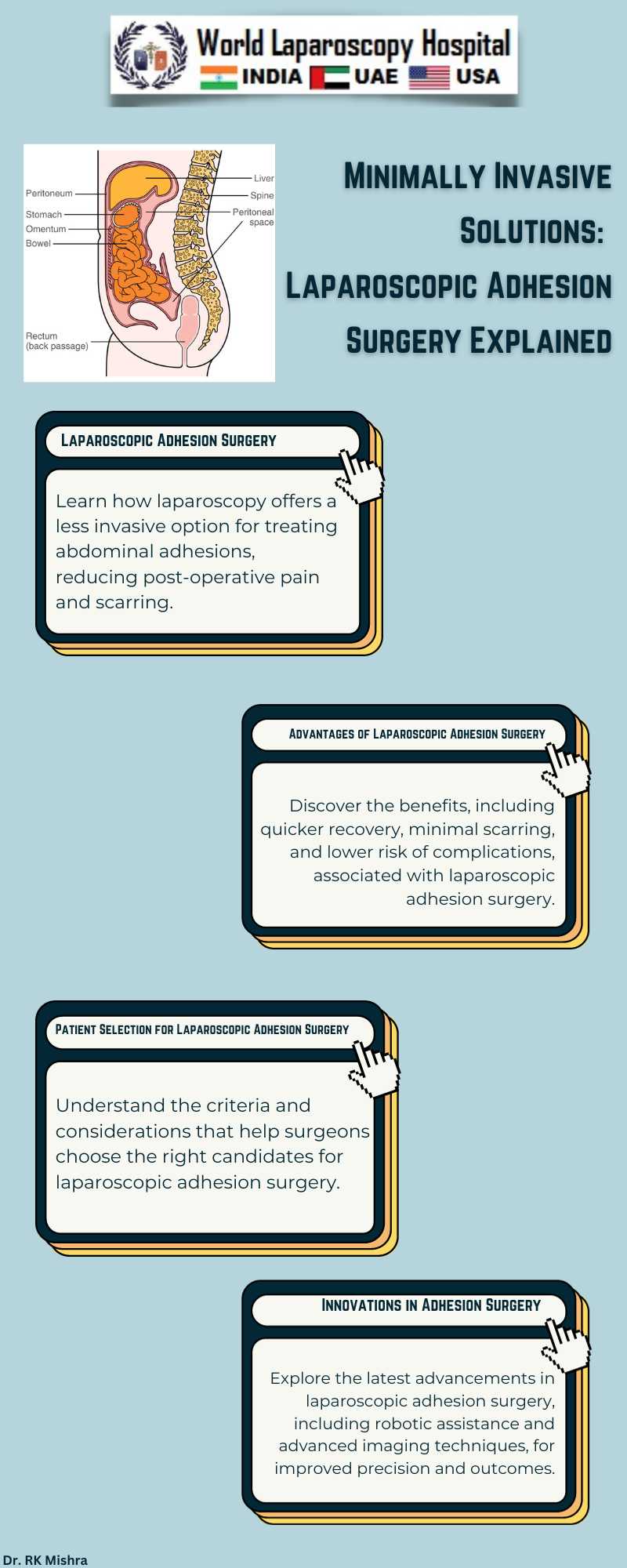Minimally Invasive Solutions: Laparoscopic Adhesion Surgery Explained
Minimally Invasive Solutions: Laparoscopic Adhesion Surgery Explained
Introduction:
In the realm of modern medicine, the emphasis on minimally invasive surgical techniques has revolutionized the way we approach various surgical conditions. Laparoscopic surgery, in particular, has gained prominence for its ability to reduce post-operative complications, shorten recovery times, and enhance patient outcomes. Among the many applications of laparoscopy, the management of abdominal adhesions stands out as a remarkable example of how minimally invasive solutions are transforming surgical practice. In this comprehensive article, we will explore the world of Laparoscopic Adhesion Surgery, unraveling its intricacies, benefits, and advancements.

Understanding Abdominal Adhesions
Before delving into the nuances of laparoscopic adhesion surgery, it is essential to grasp the concept of abdominal adhesions. These fibrous bands of tissue form between organs and tissues in the abdominal cavity, often as a result of previous surgeries, infections, or inflammation. Abdominal adhesions can lead to a range of symptoms, from mild discomfort to severe pain, bowel obstructions, and fertility issues. Traditional open surgery has historically been the primary approach to address adhesions. However, laparoscopic adhesion surgery has emerged as a less invasive and highly effective alternative.
The Evolution of Laparoscopic Surgery
Laparoscopic surgery, also known as minimally invasive surgery or keyhole surgery, has seen remarkable evolution since its inception. Surgeons initially used laparoscopy for diagnostic purposes, but it has since expanded to encompass a wide array of therapeutic interventions. The evolution of laparoscopic instruments, techniques, and technology has paved the way for its successful application in adhesion surgery.
Laparoscopic Adhesion Surgery: The Procedure
Laparoscopic adhesion surgery involves making small incisions in the abdominal wall through which a camera (laparoscope) and specialized surgical instruments are inserted. The surgeon navigates these instruments to access the adhesions and carefully separate them. The laparoscope provides a magnified view of the operative site, allowing for precise and controlled adhesion lysis. This minimally invasive approach significantly reduces trauma to the surrounding tissues and organs, leading to less pain and faster recovery.
Advantages of Laparoscopic Adhesion Surgery
1. Minimized Scarring: One of the most noticeable benefits of laparoscopic adhesion surgery is the minimal scarring. The small incisions result in tiny scars compared to the larger incisions required in open surgery.
2. Reduced Pain: Patients typically experience less post-operative pain with laparoscopic procedures, leading to decreased reliance on pain medications.
3. Quicker Recovery: Due to the minimally invasive nature of the surgery, patients can often return to their regular activities sooner than with open surgery.
4. Lower Risk of Complications: Laparoscopic surgery is associated with a lower risk of surgical site infections and other complications.
5. Improved Cosmetic Outcome: The cosmetic outcome is often more favorable, as the small incisions are less noticeable.
Indications and Patient Selection
Not all patients with abdominal adhesions are suitable candidates for laparoscopic adhesion surgery. Patient selection is crucial, and factors such as the extent and location of adhesions, previous surgeries, and overall health must be considered. This section will explore the indications and criteria for selecting patients for laparoscopic adhesion surgery.
Challenges and Considerations
While laparoscopic adhesion surgery offers numerous advantages, it is not without its challenges. Surgeons must navigate potential complications, including the risk of injury to adjacent organs, bleeding, and incomplete adhesion lysis. Additionally, the learning curve for mastering laparoscopic adhesion surgery is steep, and surgical teams must be adequately trained and experienced.
Innovations in Laparoscopic Adhesion Surgery
Advancements in technology and surgical techniques continue to enhance the field of laparoscopic adhesion surgery. Robotics, advanced imaging, and innovative instruments are being integrated to improve precision and outcomes. This section will provide an overview of the latest innovations in the field.
Patient Recovery and Post-operative Care
A crucial aspect of any surgical procedure is the post-operative care and recovery process. Patients undergoing laparoscopic adhesion surgery can benefit from specific guidelines and strategies to optimize their recovery and minimize the risk of complications. We will discuss these in detail.
Case Studies and Success Stories
To illustrate the real-world impact of laparoscopic adhesion surgery, this article will present a few case studies and success stories. These narratives will showcase how patients have benefited from this minimally invasive approach to managing abdominal adhesions.
Conclusion:
In conclusion, Laparoscopic Adhesion Surgery represents a significant milestone in the field of minimally invasive surgery. Its ability to effectively treat abdominal adhesions with minimal trauma, reduced pain, and quicker recovery times has made it a preferred choice for both patients and surgeons. As technology continues to advance and surgical expertise grows, the future of laparoscopic adhesion surgery holds even more promise in improving the lives of patients suffering from this challenging condition. Embracing minimally invasive solutions, such as laparoscopy, is a testament to the ever-evolving landscape of surgical excellence.
By understanding the intricacies of laparoscopic adhesion surgery, patients, healthcare providers, and the medical community at large can appreciate the transformational impact of this innovative approach to surgical care.
Introduction:
In the realm of modern medicine, the emphasis on minimally invasive surgical techniques has revolutionized the way we approach various surgical conditions. Laparoscopic surgery, in particular, has gained prominence for its ability to reduce post-operative complications, shorten recovery times, and enhance patient outcomes. Among the many applications of laparoscopy, the management of abdominal adhesions stands out as a remarkable example of how minimally invasive solutions are transforming surgical practice. In this comprehensive article, we will explore the world of Laparoscopic Adhesion Surgery, unraveling its intricacies, benefits, and advancements.

Understanding Abdominal Adhesions
Before delving into the nuances of laparoscopic adhesion surgery, it is essential to grasp the concept of abdominal adhesions. These fibrous bands of tissue form between organs and tissues in the abdominal cavity, often as a result of previous surgeries, infections, or inflammation. Abdominal adhesions can lead to a range of symptoms, from mild discomfort to severe pain, bowel obstructions, and fertility issues. Traditional open surgery has historically been the primary approach to address adhesions. However, laparoscopic adhesion surgery has emerged as a less invasive and highly effective alternative.
The Evolution of Laparoscopic Surgery
Laparoscopic surgery, also known as minimally invasive surgery or keyhole surgery, has seen remarkable evolution since its inception. Surgeons initially used laparoscopy for diagnostic purposes, but it has since expanded to encompass a wide array of therapeutic interventions. The evolution of laparoscopic instruments, techniques, and technology has paved the way for its successful application in adhesion surgery.
Laparoscopic Adhesion Surgery: The Procedure
Laparoscopic adhesion surgery involves making small incisions in the abdominal wall through which a camera (laparoscope) and specialized surgical instruments are inserted. The surgeon navigates these instruments to access the adhesions and carefully separate them. The laparoscope provides a magnified view of the operative site, allowing for precise and controlled adhesion lysis. This minimally invasive approach significantly reduces trauma to the surrounding tissues and organs, leading to less pain and faster recovery.
Advantages of Laparoscopic Adhesion Surgery
1. Minimized Scarring: One of the most noticeable benefits of laparoscopic adhesion surgery is the minimal scarring. The small incisions result in tiny scars compared to the larger incisions required in open surgery.
2. Reduced Pain: Patients typically experience less post-operative pain with laparoscopic procedures, leading to decreased reliance on pain medications.
3. Quicker Recovery: Due to the minimally invasive nature of the surgery, patients can often return to their regular activities sooner than with open surgery.
4. Lower Risk of Complications: Laparoscopic surgery is associated with a lower risk of surgical site infections and other complications.
5. Improved Cosmetic Outcome: The cosmetic outcome is often more favorable, as the small incisions are less noticeable.
Indications and Patient Selection
Not all patients with abdominal adhesions are suitable candidates for laparoscopic adhesion surgery. Patient selection is crucial, and factors such as the extent and location of adhesions, previous surgeries, and overall health must be considered. This section will explore the indications and criteria for selecting patients for laparoscopic adhesion surgery.
Challenges and Considerations
While laparoscopic adhesion surgery offers numerous advantages, it is not without its challenges. Surgeons must navigate potential complications, including the risk of injury to adjacent organs, bleeding, and incomplete adhesion lysis. Additionally, the learning curve for mastering laparoscopic adhesion surgery is steep, and surgical teams must be adequately trained and experienced.
Innovations in Laparoscopic Adhesion Surgery
Advancements in technology and surgical techniques continue to enhance the field of laparoscopic adhesion surgery. Robotics, advanced imaging, and innovative instruments are being integrated to improve precision and outcomes. This section will provide an overview of the latest innovations in the field.
Patient Recovery and Post-operative Care
A crucial aspect of any surgical procedure is the post-operative care and recovery process. Patients undergoing laparoscopic adhesion surgery can benefit from specific guidelines and strategies to optimize their recovery and minimize the risk of complications. We will discuss these in detail.
Case Studies and Success Stories
To illustrate the real-world impact of laparoscopic adhesion surgery, this article will present a few case studies and success stories. These narratives will showcase how patients have benefited from this minimally invasive approach to managing abdominal adhesions.
Conclusion:
In conclusion, Laparoscopic Adhesion Surgery represents a significant milestone in the field of minimally invasive surgery. Its ability to effectively treat abdominal adhesions with minimal trauma, reduced pain, and quicker recovery times has made it a preferred choice for both patients and surgeons. As technology continues to advance and surgical expertise grows, the future of laparoscopic adhesion surgery holds even more promise in improving the lives of patients suffering from this challenging condition. Embracing minimally invasive solutions, such as laparoscopy, is a testament to the ever-evolving landscape of surgical excellence.
By understanding the intricacies of laparoscopic adhesion surgery, patients, healthcare providers, and the medical community at large can appreciate the transformational impact of this innovative approach to surgical care.
2 COMMENTS
Dr. Jitendra Lodhi
#1
Nov 26th, 2023 8:37 am
Modern medicine's focus on minimally invasive techniques, notably laparoscopic surgery, transforms surgical approaches. Notably, in managing abdominal adhesions, it showcases reduced complications, shorter recovery times, and improved patient outcomes. Explore the intricacies and advancements in Laparoscopic Adhesion Surgery in this comprehensive article.
Dr. Danny Bivins
#2
Dec 3rd, 2023 9:47 am
Minimally invasive surgical techniques, especially laparoscopy, revolutionize various conditions by reducing complications and improving outcomes. Laparoscopic Adhesion Surgery exemplifies this transformation, offering minimally invasive solutions. Explore its intricacies, benefits, and advancements in this comprehensive article.
| Older Post | Home | Newer Post |








